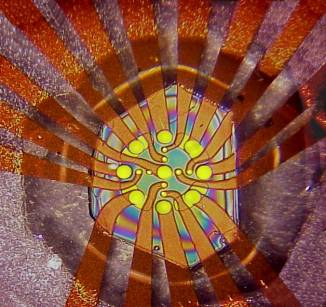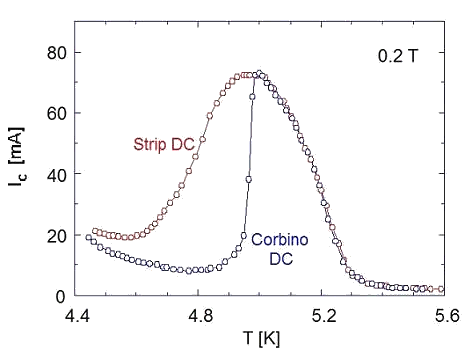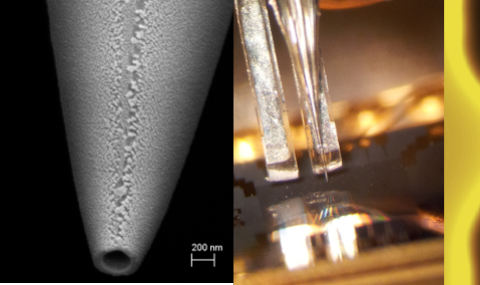The nature of the disorder-driven solid-solid transition in the vortex matter in superconductors, and the associated instabilities, have recently attracted wide attention. A closely related question is the origin of the commonly observed peak-effect, at which the critical current increases significantly in the vicinity of Hc2 in low-Tc superconductors. Since its discovery more than twenty years ago the nature of the peak-effect has been controversial. In this work we present evidence that the peak-effect reflects a first-order transition from a quasi-ordered lattice (Bragg glass) into a strongly pinned disordered phase.

Image of the sample with corbino geometry
We have carried out transport studies in NbSe2 crystals in Corbino disk geometry. In this geometry the current is injected in the center of the sample and is collected using a circular electrode. The vortices, which move perpendicular to the radial current, circulate around the center electrode without crossing the sample edges. In order to compare between the Corbino and the conventional strip configurations we have evaporated a gold mask, which enables us to study both geometries on the same crystal using the same voltage contacts (see the image above). In the lower part of the peak-effect a striking difference in the voltage response in the two geometries is found. In Corbino geometry a sharp onset of critical current is found at the peak field of the peak-effect, indicating that the vortex lattice undergoes a first-order transition from a Bragg glass into a disordered phase. This transition shows a sharp reentrant behavior at low fields.
In analogy to thermally induced melting, the quasi-long-range order of the lattice is discontinuously broken at the transition due to point-disorder induced vortex meandering. In contrast, in the conventional strip configuration, the disorder-driven transition is obscured by injection of a metastable disordered phase through the sample edges. The dynamic coexistence of metastable disordered phase with the equilibrium ordered phase results in smearing of the lower part of the peak effect and in the commonly observed vortex instabilities. By eliminating the injection of the disordered vortices, the instabilities are found to be absent in the Corbino geometry, thus allowing the study of 'intrinsic' vortex properties in the vicinity of the phase transition.

Comparison between strip geometry and Corbino geometry. In Corbino geometry a sharp onset of critical current is found at the peak field of the peak-effect, indicating that the vortex lattice undergoes a first-order transition from a Bragg glass into a disordered phase. This transition shows a sharp reentrant behavior at low fields.
This finding of the first-order disorder-driven transition in conventional superconductors is of major importance to our general understanding of the vortex matter phase diagram. The same disorder-driven transition apparently occurs at the second magnetization peak in HTS, indicating that the destruction of the Bragg glass occurs along a unified first-order transition line that changes its character from thermally-driven to disorder-driven as the temperature is decreased.
Additional information
- Instabilities and Disorder-Driven First-Order Transition of the Vortex Lattice
Y. Paltiel, E. Zeldov, Y. Myasoedov, M. L. Rappaport, G. Jung, S. Bhattacharya, M. J. Higgins, Z. L. Xiao, E. Y. Andrei, P. L. Gammel, and D. J. Bishop
Phys. Rev. Lett. 85, pp. 3712-3715 (2000). - Dynamic Instabilities and Memory Effects in Vortex Matter
Y. Paltiel, E. Zeldov, Y. N. Myasoedov, H. Shtrikman, S. Bhattacharya, M. J. Higgins, Z. L. Xiao, E. Y. Andrei, P. L. Gammel, and D. J. Bishop
Nature 403, pp. 398-401 (2000).


